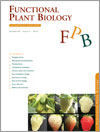
Functional Plant Biology
Volume 39 Number 4 2012
Cytokinins are evolutionally conserved low-mass molecules involved in RNA translation in various organisms from bacteria to humans. In plants, they evolved into an important group of hormones controlling plant life processes, and the mechanisms have been adopted by plant-interacting organisms to engineer plant developmental programmes. The review describes the biochemistry, mechanisms and strategies of organisms employing cytokinins in the evolutionary context.
FP11238 Leaf structural responses to pre-industrial, current and elevated atmospheric [CO2] and temperature affect leaf function in Eucalyptus sideroxylon
Climate change may affect plant carbohydrate production through effects on leaf structure and chemistry, yet the role of leaf structure is poorly understood. We addressed this issue using an ecologically important eucalypt species grown in rising CO2 and temperature and observed that both leaf nitrogen and thickness played key roles regulating climate change effects. Our results indicate that understanding the effects of climate change on plant carbohydrate production requires examining changes in both leaf structure and chemistry.
FP11206 Concomitant dendrometer and leaf patch pressure probe measurements reveal the effect of microclimate and soil moisture on diurnal stem water and leaf turgor variations in young oak trees
To date, little is known about the dependency of internal tree water relations on environmental fluctuations. In the present study, we performed concomitant dendrometer and leaf patch pressure measurements on young oak trees revealing the influence of microclimate and soil moisture on diurnal changes in stem water storage and leaf turgor. Knowledge on these changes may advance our understanding how trees cope with temporal water deficits.
FP11282 Lower soil moisture threshold for transpiration decline under water deficit correlates with lower canopy conductance and higher transpiration efficiency in drought-tolerant cowpea
Terminal drought tolerance implies that plants have enough water to fill grains. Water-saving traits, measured in tolerant and sensitive cowpea lines, showed that tolerant lines have developed several closely related constitutive mechanisms that reduce the rate of water use and delay drought effects. This opens the possibility of deciphering their genetic basis for the development of drought-tolerant cowpea cultivars.
FP11248 Tree age-related effects on sun acclimated leaves in a chronosequence of beech (Fagus sylvatica) stands
Studying the physiology of leaves in tall forest tree canopies remains a challenging task, yet crucial to understanding the decrease of forest productivity with age. We investigated sun leaf physiology in 14–175-year-old beech stands using a new optical method and found significant changes in leaf morphology related to tree age, but no change in leaf composition. Our results could impact the method of leaf sampling in tall trees and contribute to the knowledge of age-related changes in deciduous trees.
FP11232 Differences in morpho-physiological leaf traits reflect the response of growth to drought in a seeder but not in a resprouter Mediterranean species
Global warming will cause an increase in the intensity and frequency of droughts in Mediterranean areas. We report the responses of two species with contrasting leaf characteristics and post-fire regeneration strategies during a severe simulated drought. We found a contrasting response to water availability, indicating that the projected changes could alter the competitive ability of these species and contribute to changes in plant dominance in Mediterranean shrublands.
FP11246Validation of reference genes for real-time quantitative PCR normalisation in non-heading Chinese cabbage
Quantification of gene expression is an important tool to study genes involved in traits of interest but requires normalisation using uniformly expressed genes. We demonstrated that no single candidate reference gene was uniformly expressed in non-heading Chinese cabbage comparing different tissues, developmental stages and abiotic- and biotic stress treatments. Thus, depending on the trait under investigation, different sets of 2–5 reference genes should be used for normalisation and published gene expression studies should be interpreted with caution.
FP11293 Non-climacteric ripening in strawberry fruit is linked to ABA, FaNCED2 and FaCYP707A1
To examine the role of ABA in strawberry ripening, two ABA synthetase genes FaNCED1, FaNCED2 and one ABA degradation enzyme gene FaCYP707A1 were cloned and analysed. Results show that ABA may play a regulation role in fruit ripening and was regulated by FaNCED2 and FaCYP707A1. These findings contribute new information to the field of hormonal control of non-climacteric fruit ripening.



